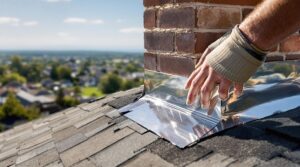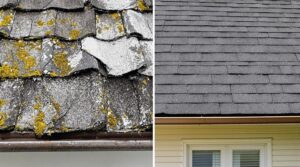Ever wondered if you can get a fresh new roof while keeping your trusty gutters in place? Good news – you absolutely can! Think of it as changing your shirt while keeping your necklace on – it's totally doable with the right approach.
Let's break down when you can keep those gutters hanging:
- Your gutters are in great shape (no sagging or damage)
- The attachments are rock-solid
- You've got proper access to install drip edge flashing
Today's skilled roofers have some pretty clever tricks up their sleeves. They use specialized equipment and temporary supports – kind of like scaffolding for your gutters – to protect them during the roof replacement. It's like performing a delicate dance around your existing drainage system.
But hold on! Sometimes those gutters might need to come off. Watch out for:
- Significant gutter damage
- Previous installation problems
- Local building regulations that demand removal
The key is getting a professional assessment of your specific situation. Just like a doctor wouldn't prescribe without examining you first, a qualified roofer needs to evaluate your roof-gutter relationship before making the call.
Want to make the smartest choice for your home? Have an expert check your gutter system's condition before starting your roofing project. This way, you'll know exactly what approach works best for your unique situation.
Key Takeaways
Wondering if you can save those trusty gutters during your roof makeover? Let's dive in!
Think of your gutters as loyal guardians of your home's foundation – they don't always need to take a vacation when your roof gets a facelift. Smart roofers can work their magic around your existing gutter system using clever support brackets and specialized tools, much like a surgeon operating with precision instruments.
But here's the real scoop: keeping your gutters hanging around during a roof replacement is a bit like walking a tightrope. While it might save you some cash upfront, those falling shingles and debris could turn your penny-wise decision into a pound-foolish outcome. Plus, your gutters might be hiding some sneaky fascia problems underneath, like a poker player concealing a bad hand.
Before you make the call, check your local rulebook – some building codes and warranty fine print insist on gutter removal, no ifs, ands, or buts. And if your gutters are showing their age with rust spots or creating mini-pools of water where they shouldn't, it's time to bid them farewell along with your old roof.
Pro tip: a skilled roofing team can install fresh flashing and drip edges around existing gutters, but it's like threading a needle – it demands extra expertise and patience. Want to play it safe? Consider your gutter's condition and local regulations before rolling the dice on keeping them in place.
Factors That Determine If Gutters Can Stay in Place
Want to Know if Your Gutters Can Stay Put During a Roof Replacement?
Let's talk about the make-or-break factors that determine whether those trusty gutters of yours can hang tight while your roof gets a makeover. Think of your gutter system like a partner in a dance – it needs to be strong, stable, and in sync with your roof to stick around during the big performance.
First up, we need to check your gutters' health. Just like you wouldn't run a marathon with a sprained ankle, damaged or loosely hanging gutters won't make it through the roofing process. The real MVPs here are gutters that have maintained their structural integrity and secure attachments.
Your roof's personality matters too! Is it as steep as a ski slope or more complex than a puzzle? These characteristics play a huge role in whether your gutters can stay or need a temporary vacation.
The drip edge flashing – that's like the middleman between your roof and gutters – needs special attention, as roofers often need to get underneath to ensure everything's sealed tight.
Don't forget about those hidden heroes – the gutter fasteners and fascia board. They're like the foundation of a house; if they're not rock-solid, keeping those gutters in place could be risky business.
And here's something many homeowners don't realize: local building codes and warranty requirements might actually insist on gutter removal, regardless of their condition.
Risks and Benefits of Keeping Gutters During Roof Replacement
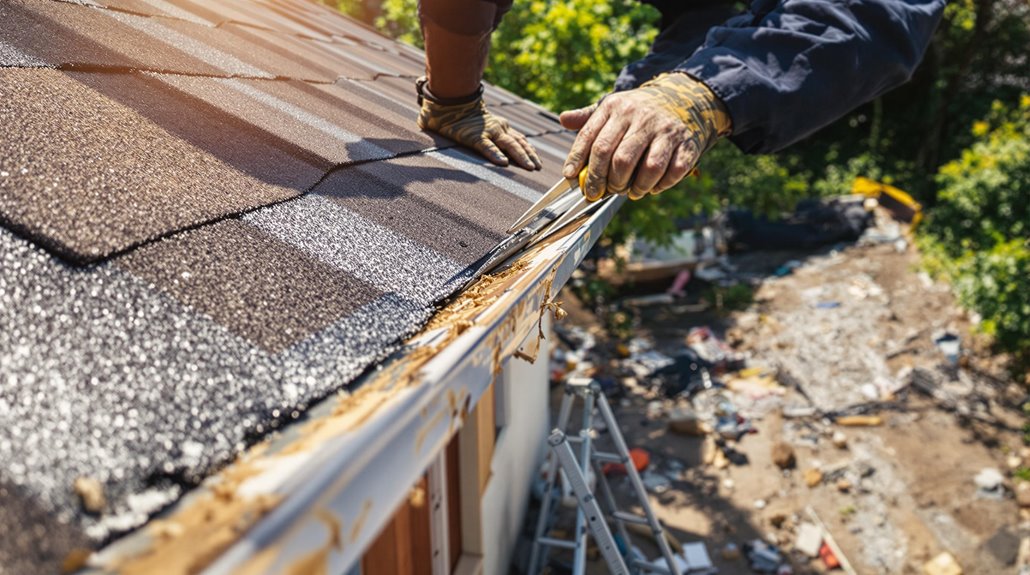
Should You Keep Your Gutters During a Roof Replacement? Here's What You Need to Know
Ever wondered what happens to your trusty gutters when it's time for a new roof? Let's dive into this often-overlooked aspect of roof replacement that can make or break your home's water management system.
Think of your gutters as your roof's loyal sidekicks – they've been defending your home against water damage for years. But when it's time for a roof makeover, you're faced with a tough decision: should they stay or should they go?
Keeping your gutters intact might seem like a money-saving move (and it often is!), but there's more to consider than just your wallet. Here's what you're looking at:
The Good Stuff:
- Save money on replacement costs
- Preserve your existing drainage system
- Maintain your home's familiar water flow patterns
The Tricky Parts:
- Your gutters might take a beating from falling shingles and construction debris
- Installing new roof edges becomes like threading a needle – precise but challenging
- Roofers might need their ninja skills to work around them
- Hidden fascia problems could go unnoticed
Pro Tip: Think of it as trying to change your shirt while wearing a jacket – it's doable but requires extra care and skill!
Success largely rides on three factors:
- How well your current gutters are holding up
- How they're attached to your home
- Your roofer's experience with gutter preservation techniques
Want to make the right choice? Have your contractor assess your gutters' condition before making the final call. Sometimes, keeping them is smart; other times, it's like trying to save a worn-out pair of shoes – not worth the hassle!
Having a licensed contractor estimate is crucial for determining whether your gutters can safely remain during roof replacement.
Professional Methods for Working Around Existing Gutters
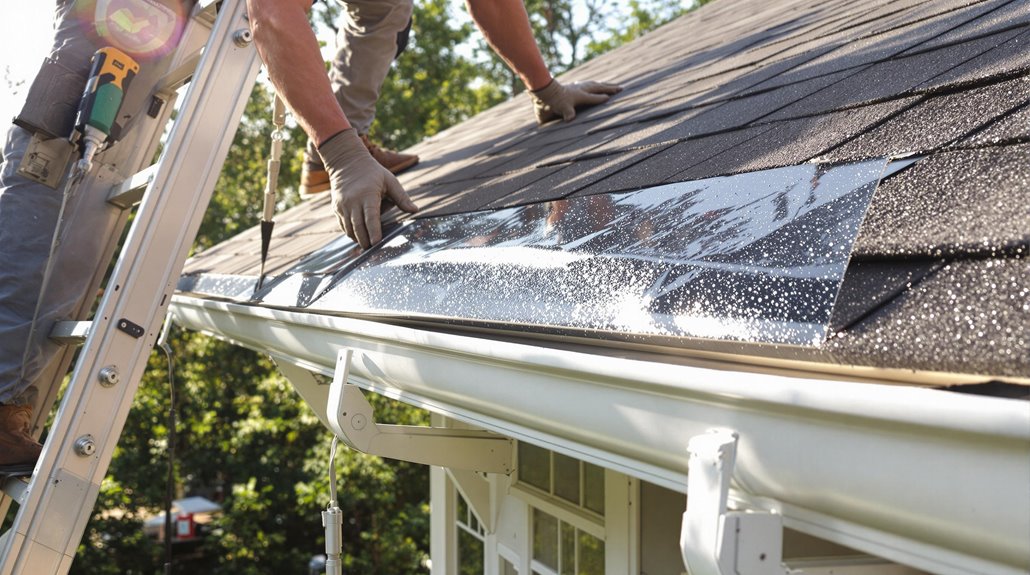
Want to know how the pros handle those tricky gutter situations during roof replacements? Let's dive into their clever tricks of the trade!
Think of gutters as your roof's loyal sidekicks – you can't just rip them off during a roofing job. That's why savvy roofers start by setting up what I like to call "gutter guardians" – temporary support brackets that keep everything rock-solid while they're working their magic above.
Ever tried threading a needle while wearing mittens? That's kind of what it's like working around gutters, but these pros have it down to a science. They've got specialized tools that let them slip new flashing behind existing gutters like ninjas, and they're masters at installing drip edges and underlayment without disturbing your drainage system.
The real artistry comes into play around those gutter hangers. It's like playing architectural Tetris – every shingle needs to fit perfectly while maintaining that crucial spacing for water flow. Some roofers even use nifty spacer tools (think tiny roofing chopsticks) to ensure everything's aligned just right.
And here's a pro tip: many contractors will seize this opportunity to upgrade your gutter game by adding protection systems. These smart additions keep leaves and debris from crashing your roof-to-gutter party, making maintenance a breeze down the road.
When Gutter Removal Is Absolutely Necessary
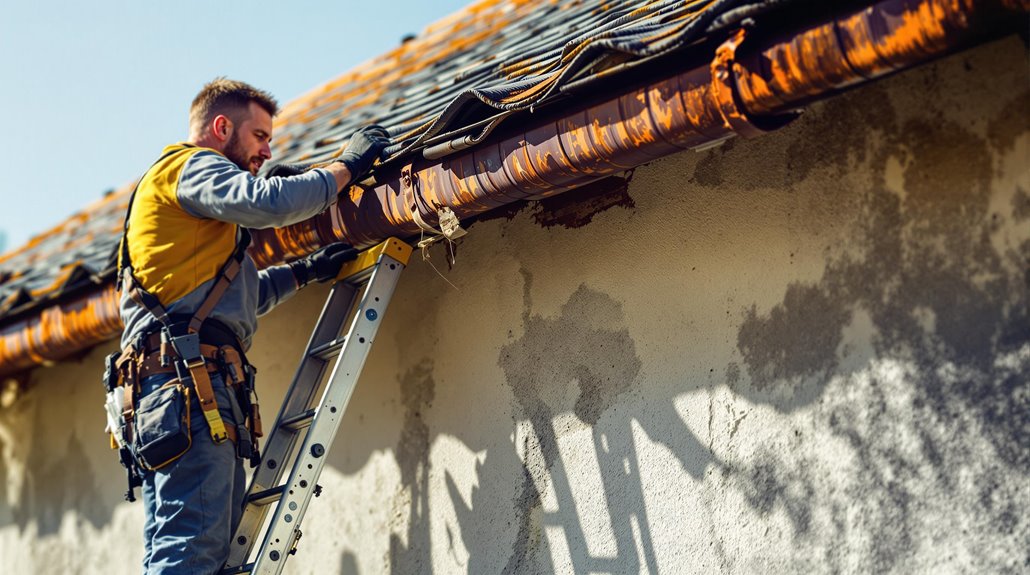
Is It Time to Say Goodbye to Your Gutters? Here's When Removal Can't Wait
Let's face it – nobody wants to remove their gutters during a roof replacement if they don't have to. But sometimes, just like that worn-out pair of shoes you've been holding onto, your gutters simply need to go.
Think of your gutters as your home's first line of defense against water damage. When they're compromised, you're essentially letting your house go into battle without armor.
So how do you know when removal is non-negotiable?
Key Signs You Need Complete Gutter Removal:
- Your gutters look like they've been through a war (think severe rust spots, splits, or sections pulling away from the house)
- The original installation is about as straight as a roller coaster track (improper pitch means water pooling)
- You're upgrading to modern drip edge systems that need a clean slate to work their magic
The Removal Game Plan:
When your trusted roofer determines it's time for removal, they'll approach it like a careful game of Operation.
They'll methodically disconnect each component – from fasteners to brackets – while preserving what can be salvaged.
Smart contractors time this delicate operation with weather patterns (because nobody wants a surprise shower during the process).
They'll also set up temporary drainage solutions – think of it as setting up an understudy while the main actor is off stage.
Remember: Sometimes taking a step back (removing those gutters) is essential for moving two steps forward toward a watertight, properly functioning roof system.
Protecting Your Gutters During Roof Installation

Want to Keep Your Gutters Safe During a Roof Makeover? Here's the Scoop!
Think of your gutters as the unsung heroes of your home's drainage system – they deserve some serious protection when you're getting a new roof! Just like you'd wear protective gear before tackling a tough job, your gutters need their own armor during roof replacement.
Smart roofers know the drill: they use clever tricks like temporary support brackets (think of them as gutter bodyguards) and angled shields that bounce debris away like a mini-pinball machine. It's all about keeping those gutters ding-free and fully functional!
Ever seen a well-orchestrated ballet? That's how your roofing team should work around your gutters. They'll set up plywood or heavy-duty tarps at just the right angles – creating what I like to call a "gutter umbrella." This setup catches everything from pesky nail drops to wandering shingle granules that might otherwise turn your gutters into a debris collection system.
But wait, there's more to this protective puzzle! Professional contractors get creative with ladder placement (no direct gutter hugging here!) and use standoff stabilizers – think of them as ladder kickstands that keep pressure off your gutters.
And those temporary downspout extensions? They're like emergency escape routes, whisking away debris before it can pile up around your foundation.
Remember: protecting your gutters isn't just about preventing damage – it's about preserving your home's entire water management system. When done right, your gutters will emerge from the roof replacement ready to tackle their next rainstorm challenge!
The Benefits Of Consulting A Public Adjuster

When replacing a roof, consulting a public adjuster can provide essential expertise in evaluating damage and maximizing insurance claims, with studies showing settlements up to 800% higher compared to unassisted claims.
A licensed public adjuster conducts thorough, objective evaluations of roof and gutter systems while meticulously documenting all damage for insurance purposes. Their professional oversight streamlines the claims process through detailed documentation, expert negotiation, and extensive understanding of policy coverage, ensuring homeowners receive appropriate compensation for roof replacement costs.
Most public adjusters maintain 24-hour response times and provide claim status updates every 10 days to keep homeowners informed throughout the process.
Expertise In Insurance Claims
Ever wondered why some homeowners breeze through insurance claims while others struggle? The answer often lies in having a public adjuster in your corner. Think of them as your personal insurance claim architects – they're licensed pros who know exactly how to build your case from the ground up.
Did you know that working with a public adjuster can boost your settlement by up to 800%? That's not just pocket change – it's the difference between a basic repair and a proper roof replacement that truly protects your home.
What makes these insurance whisperers so effective?
- They speak "insurance-ese" fluently, translating complex policy jargon into plain English.
- They're like CSI investigators for your roof, capturing every detail that matters.
- They're master negotiators who know exactly what makes insurance companies tick.
Here's their winning game plan:
- They perform detective-level property inspections, armed with cameras and keen eyes to spot damage others might miss.
- They craft bulletproof claims packages, leaving no dollar uncounted.
- They go to bat for you during negotiations, using industry insights to unlock maximum value.
When should you definitely call a public adjuster? Think of these scenarios:
- Your roof damage claim looks like a puzzle with missing pieces.
- The insurance company's offering feels more like a lowball than a lifeline.
- You're drowning in paperwork and insurance terminology.
For catastrophic or complex claims, public adjusters may charge up to 30% commission rate based on the final settlement amount.
Objective Damage Assessment
Think of a public adjuster as your property's detective – someone who uncovers every bit of damage with the precision of a CSI investigator. When your home takes a hit, their unbiased evaluation becomes your secret weapon in dealing with insurance companies.
Ever wondered what makes their assessment so powerful? They don't just glance at your roof and call it a day. These pros dig deep, examining everything from those tricky spots where shingles meet valleys to the hidden impact on your gutters' performance. It's like getting a full-body scan for your house!
Your insurance claim deserves more than just a quick once-over. That's why public adjusters meticulously document everything – from that tiny crack that could spell trouble down the road to major structural concerns that need immediate attention.
They're essentially building your case with bulletproof evidence, combining high-resolution photos, detailed reports, and expert analysis.
Want to know the best part? They speak the insurance industry's language fluently. When they spot those sneaky signs of damage that most people miss – like subtle underlayment deterioration or hidden moisture intrusion – they know exactly how to present these findings in a way that insurance companies can't ignore.
Think of them as your property's skilled translator, turning complex damage patterns into clear, undeniable proof for your claim.
Remember, what you can't see CAN hurt your wallet. A public adjuster's thorough evaluation ensures you're not left holding the bag for repairs that should be covered by your policy.
They're not just evaluating damage; they're protecting your investment's future.
With statistics showing that claims with adjusters settle up to 800% higher than those filed without professional help, having an expert on your side is clearly worth the investment.
Streamlined Claim Process
Need a Secret Weapon for Your Insurance Claim? Meet Your Public Adjuster!
Ever felt like you're playing chess with insurance companies while they're playing 4D chess? That's where public adjusters come in – they're like your personal insurance claim superheroes. These licensed pros don't just handle your claim; they transform it into a well-oiled machine that actually works for you.
Think of a public adjuster as your claim's GPS system – they'll navigate you through the insurance maze while you focus on getting your life back to normal. They're diving deep into damage assessments, crunching numbers, and speaking the insurance industry's language (so you don't have to).
Why should you care? Well, the numbers speak volumes. Claims handled by public adjusters typically see up to 800% higher settlements than DIY attempts. That's not just a win – it's a game-changer for your recovery.
Here's what makes public adjusters your secret weapon:
- They're speed demons at documentation, turning paperwork chaos into organized brilliance.
- They've got negotiation skills that would make Wall Street jealous.
- You get to hand over the stress-inducing paperwork while they handle the heavy lifting.
Unlike insurance company adjusters who follow company guidelines, public adjusters work solely to protect your interests as the policyholder.
The best part? While they're maximizing your settlement potential, they're also keeping everything squeaky clean with insurance regulations. It's like having a professional athlete on your team – they know the rules, play by them, and still score big wins.
Want to turn your insurance claim from a headache into a success story? A public adjuster might just be your ticket to a smoother, more profitable claims journey.
Higher Claim Payouts & Settlements
Want to know the game-changing secret behind successful insurance claims? Public adjusters are like your personal claim champions, helping policyholders secure dramatically higher settlements – often 4-8 times more than going it alone.
Think of public adjusters as skilled detectives who know exactly where to look for hidden damage and understand the complex language of insurance policies. They're your expert negotiators who speak the insurance company's language and know how to present your case for maximum value.
While their fee typically ranges from 10-20% of your settlement, consider this investment like hiring a seasoned tax professional – they often find deductions you didn't know existed.
These pros bring a complete toolkit: meticulous damage documentation, precise cost analysis, and battle-tested negotiation strategies that insurance companies respect.
Ever wondered why some claims get settled quickly while others drag on? Public adjusters shine brightest when dealing with tricky situations – whether it's extensive storm damage to your home or when your insurer's initial offer seems suspiciously low.
They're especially valuable when you're feeling overwhelmed by the claims process or when there's significant property damage at stake.
Through their systematic approach and industry expertise, these claim specialists turn complex insurance procedures into clear paths toward fair compensation.
It's like having an insider guide who knows all the shortcuts to optimal claim outcomes.
As members of the Public Claims Adjusters Network, these professionals undergo mandatory yearly audits to maintain the highest standards of service.
About The Public Claims Adjusters Network (PCAN)
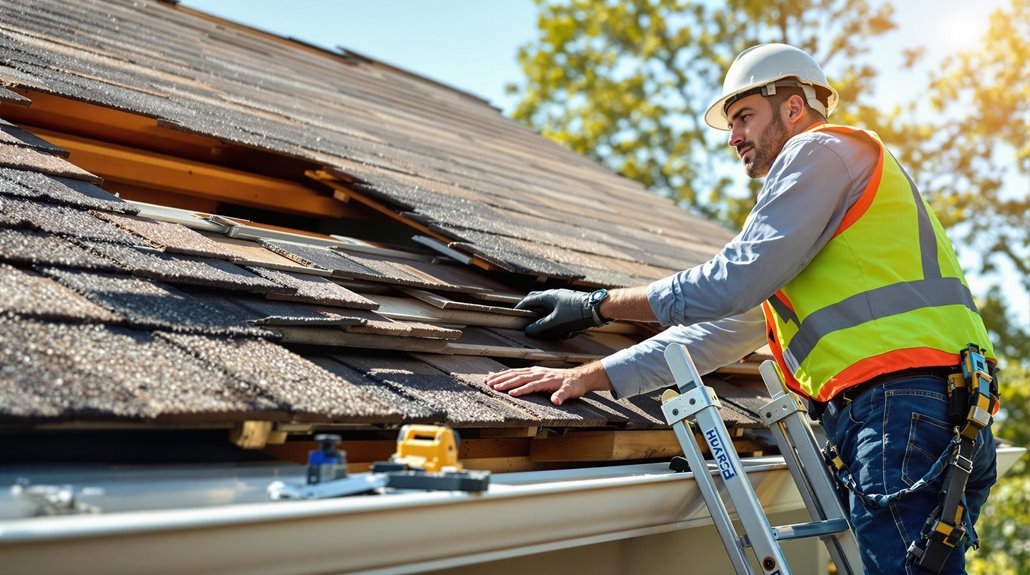
The Public Claims Adjusters Network isn't just another industry group – think of it as your personal insurance claim dream team. We're talking about an elite squad of state-licensed public adjusters who've proven they're the real deal through comprehensive vetting that would make FBI background checks look casual.
Ever wondered who's got your back when disaster strikes? PCAN members are spread across 40+ states, ready to tackle both your home and business property claims with the precision of a Swiss watchmaker. Whether it's water damage, fire restoration, or storm recovery, these pros have seen it all – and then some!
What makes PCAN adjusters different? Here's the scoop:
- They're masters of their craft, handling everything from minor leaks to major catastrophes.
- Each member passes through an application process tougher than getting into some Ivy League schools.
- Annual license checks and performance reviews keep everyone at the top of their game.
Why does this matter to you? Picture trying to navigate an insurance claim alone – it's like doing your taxes blindfolded while riding a unicycle.
PCAN connects you with battle-tested adjusters who speak the complex language of insurance and fight for what you deserve.
Trust us, when it comes to protecting your property interests, you want someone who knows the difference between a deductible and a depreciation calculation – and can explain it in plain English.
That's exactly what PCAN delivers: professional expertise with a human touch, helping turn insurance nightmares into success stories.
With contingency-based fees in nearly every state, you won't pay anything unless your claim is successfully settled.
Frequently Asked Questions
How Much More Expensive Is Roof Replacement When Keeping Gutters Attached?
Maintaining attached gutters during roof replacement typically increases labor expenses by 15-25%. Cost considerations include additional time for careful maneuvering around gutters and potential repairs if damage occurs during installation.
Can I Replace Only Sections of My Roof While Keeping Gutters?
As clear as day, sectional roof repairs remain viable while maintaining gutter protection. Professional contractors can execute partial replacements, though proper integration with existing roofing materials demands careful technical consideration.
Will My Gutter Warranty Remain Valid After a Roof Replacement?
Most gutter warranties remain valid after roof replacement if proper installation protocols are followed and no damage occurs. However, homeowners should review warranty terms and notify manufacturers about roofing work beforehand.
How Long Does Roof Replacement Take When Working Around Existing Gutters?
The standard roofing timeline extends 1-2 days when preserving existing gutters, requiring additional gutter protection measures and careful maneuvering around edges. Factors like home size and weather affect completion time.
Should I Clean My Gutters Before or After the Roof Replacement?
Proper gutter maintenance requires cleaning before roof replacement to guarantee debris doesn't interfere with installation. A second cleaning after roof preparation helps remove any shingle granules and roofing materials.







